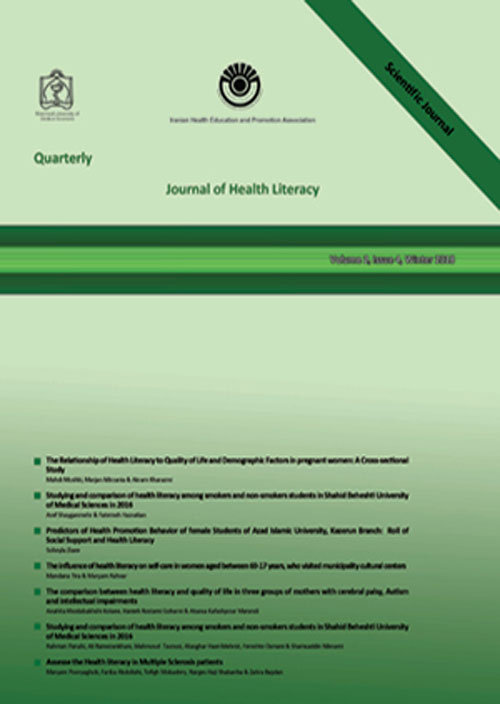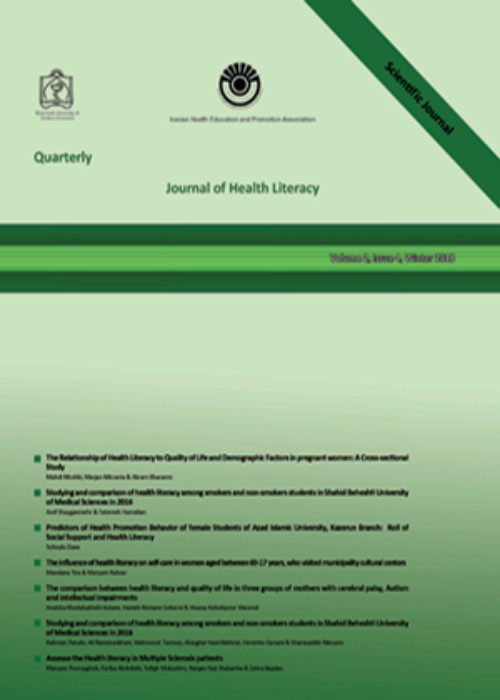فهرست مطالب

Journal of Health Literacy
Volume:6 Issue: 2, Summer 2021
- تاریخ انتشار: 1400/06/24
- تعداد عناوین: 7
-
-
Pages 9-20Background and ObjectivePregnancy is an important period for women. Pregnant women’s health literacy level usually increases during pregnancy and they gain a positive perception of health because they try to benefit from health services, and they are most willing to learn health-related information. The aim of this study is to examine the level of health literacy and health perception of pregnant women.Materials and MethodsThis descriptive study was conducted on 109 pregnant women who referred to the family health center in Suşehri, a district of Sivas, a province in the eastern part of the Central Anatolia region of Turkey, from February 2018 to February 2019. Pregnant Women Information Form, Health Literacy Survey, and Health Perception Scale were used to collect the data. Data were analyzed by the frequency test, t-test, One Way ANOVA, and correlation analysis.ResultsIn the study, the mean scores of health literacy and health perception in participants were 89.86 ± 15.01 and 45.49 ± 9.53 respectively. The analysis of the health literacy and health perception of the pregnant women in terms of their education status demonstrated that mean scores of the health literacy and health perception were significantly (p <0.05) increased with increasing education level of pregnant women. In this study, the participants had the highest level of literacy that had higher perception from their health, intended pregnancy, the interval between two pregnancies (months ≥ 24), and they used the modern family planning method after delivery.ConclusionThe results obtained in the study demonstrated that the level of health perception and health literacy were sufficient in pregnant women, and education, intended pregnancy, and perception of pregnancy can affect level of health perception and health literacy. Therefore, women’ health literacy levels should be determined and improved during preconception care.Keywords: pregnancy, Literacy, Health Literacy, Perception of health
-
Pages 21-32Background and ObjectiveAlthough compliance with self-care behaviors is necessary for the successful management of diabetes, patients with diabetes often refuse favorable self-care. This study was conducted to determine the factors influencing self-care behaviors among type-2 diabetic patients who had limited health literacy based on social cognitive theory (SCT).Materials and MethodsA cross-sectional study was conducted among 293 diabetic patients with limited health literacy that was identified by S-TOFHLA. The data were collected using the summary of diabetes self-care activities, diabetes management self-efficacy scale, outcome expectancies questionnaire, and a researcher-made questionnaire for collecting data related to self-regulation and social support constructs. Data were analyzed by SPSS ver.22 using multiple linear regression to determine the predictors of self-care behaviors.ResultsIn the case of patient’s adherence to self-care tasks, they had the best adherence to medication regime and the worst adherence to physical activity. Employment status (p <0.032, β=3.57), supplementary insurance (p <0.018, β=1.74), and history of participating in diabetes education classes (p <0.044, β=1.63) were predictors of self-care behaviors in the studied patients. Among the SCT constructs, perceived self-efficacy (p <0.001, β=0.21) predicted self-care ability. The mean score of self-care increased around 0.21 by increasing one single unit of self-efficacy. Overall, these factors predicted 67% (R2 = 0.67) of self-care changes.ConclusionsThe results of this study showed that self-efficacy and demographic variables are significant predictors to improve self-care ability among diabetic patients with limited health literacy.Keywords: self-care behavior, Health Literacy, Diabetes, Social cognitive theory
-
Pages 33-40Background and ObjectiveHealth-promoting lifestyle is a valuable factor in improving quality of life. In the care system, health ambassadors have an undeniable role in the development of health behaviors in the community. This study was conducted to investigate lifestyle and the relationship between health literacy in health ambassadors in Urmia.Materials and MethodsIn this cross-sectional study in 2019, 200 ambassadors were selected using cluster random sampling. Data collection tools were a questionnaire including demographic characteristics, Lifestyle Questionnaire (LSQ), and Health Literacy Questionnaire (HELIA). Data were entered into SPSS software version 20 and analyzed by descriptive statistics, analysis of variance, and Spearman correlation coefficient.ResultsThe results of this study showed that the lifestyle of health ambassadors was 13.5% at the poor level, 60.4% at the moderate level, and 26.1% at the good level. Lifestyle was also significantly associated with variables of gender (p=0.01), marital status (p=0.02) and occupation (p=0.008). The results of Spearman correlation showed that lifestyle with all its sub-domains had a positive and significant correlation with (p <0.001) health literacy.ConclusionGiven the importance of lifestyle in health ambassadors, it seems that educational programs to increase health literacy can be effective in improving the lifestyle among health ambassadors.Keywords: lifestyle, health, Literacy, Ambassadors
-
Pages 41-52Background and ObjectiveSelf-efficacy is an important factor in the acceptance of health behaviors. The positive effects of having healthy eating habits at all ages have been proven. However, poor eating habits are common among adolescents around the world. Understanding self-efficacy can help maintain and improve health-promoting behaviors. The aim of this study was to evaluate the validity and reliability of the self-efficacy questionnaire to regular eating habits among female students aged 15-18 years in Chenaran.Materials and MethodsThis cross-sectional research was conducted in the academic year 2016 to 2017. In this study, 439 students in Chenaran were selected using cluster sampling. After translating the questionnaire, using Jones approach, the reliability and validity of the questionnaire were evaluated using Cronbach's alpha, content validity indices, content validity ratio index, and confirmatory factor analysis.ResultsThe mean age of students participating in the study was 16.51 ± 1.04 and their mean body mass index was 21.40 ± 3.64. Content Validity Ratio (0.80 ) and Content Validity Index (0.97 ) were at an acceptable level for all the questionnaire's items. The level of Cronbach's alpha in the self-Efficacy questionnaire to regulate eating habits questions was 0.924. Confirmatory factor analysis findings showed acceptable fit indices (CFI = 0.892, TLI = 0.879, RMSEA = 0.062, d¦/c2 =656/978/247=2/660).ConclusionThe Persian version of the Self-Efficacy to Regulate Eating Habits is a useful and valuable tool for assessing levels of eating habits. This questionnaire can be used in future research because it shows good factorial validity and adequate reliability.
-
Pages 53-60Background and ObjectiveHealth-promoting behaviors are fundamental and important activities for the development and maintenance of health in individuals. However, people with inadequate health literacy are in a worse health position. Today, health literacy is considered a main factor involved in healthcare outcomes and costs. The present research aimed to determine the level of health literacy among the 18–64-year-old residents of Hormozgan Province in association with health promotion behaviors.Materials and MethodsThis cross-sectional study on 840 subjects aged from 18 to 64 years, who referred to the urban and rural health centers in Hormozgan, Iran. They were selected through a multi-stratified sampling method in 2017. The data collection instrument was a questionnaire comprised of a demographic section, the test of functional health literacy in adults (TOFHLA), and Walkers’ health promoting lifestyle profile (HPLP-II). The data were analyzed by SPSS version 23 based on the descriptive and analytical statistics tests.ResultsThe mean and standard deviation of the subjects’ age was 30.6±8.2 years. Most of the participants (586, 72.2%) had an adequate level of health literacy and 226 subjects (27.8%) had inadequate health literacy. The mean and standard deviation of the overall health promotion behavior was found to be 142.95±20.11, interpreted as an acceptable level. The highest average value was observed in the subclass of self-actualization (27.7±4.9) and the lowest mean related to the subclass of physical activity (17.4±5.4). Internet (43.1%) and appealing to the healthcare team (36.9%) were 43.1% and 36.9%, respectively.ConclusionOur findings showed that educational plans are essential based on different domains of health promotion behaviors with a focus on physical activity. It is also necessary to plan for educating different dimensions of health literacy in the virtual world and social health networks.Keywords: Health Literacy, Health Behavior, health promotion, Iran
-
Pages 61-68Background and ObjectiveHeart failure is one of the most common cardiovascular disorders and also it is one of the main problems of general health in the current society. Considering the role of health literacy in improving the quality of life of patients, the present study was conducted to determine the health literacy status of patients with heart failure hospitalized in Shahid Mohammadi Hospital in Bandar Abbas and its relationship with quality of life in these patients.Materials and MethodsThis cross-sectional study was performed on 200 patients with heart failure hospitalized in Shahid Mohammadi Hospital in Bandar Abbas in 2019. Sampling was random sampling in even days of week. Data was collected by two questionnaires including standard questionnaire of health literacy and the Minnesota Quality of Life Questionnaire (MLHF). The reliability of each scale was tested by Cronbach alpha. Data were analyzed by descriptive statistics and Pearson correlation test using SPSS 21 software.ResultsThe average level of health literacy and the quality of life were 34.60 and 79.10, respectively. Health literacy cannot be ranked as a predictor of quality of life in heart failure patients. However, a significant relationship was observed between functional, communicational and critical dimension of health literacy and mental dimension of quality of life.ConclusionParticipants in our study had poor quality of life. Their health literacy also was inadequate. Although this study did not find any meaningful relationship between health literacy and quality of life, attention to improving the level of health literacy and quality of life in all dimensions in this group of patients seems necessary.Keywords: Health Literacy, heart failure, Quality of life
-
Pages 69-77Background and Objective
Poor mental health literacy is a major obstacle to seeking help for mental health problems in adolescents. The purpose of this study was to investigate the effect of school-based educational interventions on improving mental health literacy (MHL) in adolescents.
Materials and MethodsIn this study, a search was conducted in Scopus, PubMed, Web of Science, Google Scholar, Irandoc, Magiran, and SID databases in both Persian and English language for studies published from 2011 to 2021. The keywords "adolescent", "mental health literacy", "depression literacy", "intervention", "education", and "high school" were searched in both languages. Out of 191 articles extracted and finally, 6 articles were included in this study.
ResultsThe results of the study conducted in Norway showed that the individual’s health literacy who participated in the all "Mental Health" program was significantly increased compared to those in the control group; findings of a study conducted in Australia reported that MHL in the intervention group was significantly higher than the control group after intervention (P <0.05). But, attitudes toward seeking help did not change. A Canadian study indicated that the mental health curriculum significantly increased mental health knowledge and reduced mental tagging (P <0.001); furthermore, an Iranian study demonstrated that the mean score of MHL in the intervention group was significantly increased compared to the control group after the educational intervention (P <0.001). In the study, which was conducted in the US, depressive literacy in the intervention group was significantly increased 4 months after the intervention. However, results of one study showed that education intervention is more effective than contact based intervention with an ill person (P <0.001).
ConclusionEvidence highlights that although studies have used a variety of methods for adolescent mental health literacy interventions in schools, all studies have had a positive effect on mental health literacy. Given that studies used self-report assessment to measure MHL outcomes. Thus, confirmation of these findings with objective tools is still needed.
Keywords: Mental Health Literacy, Adolescent, Education


